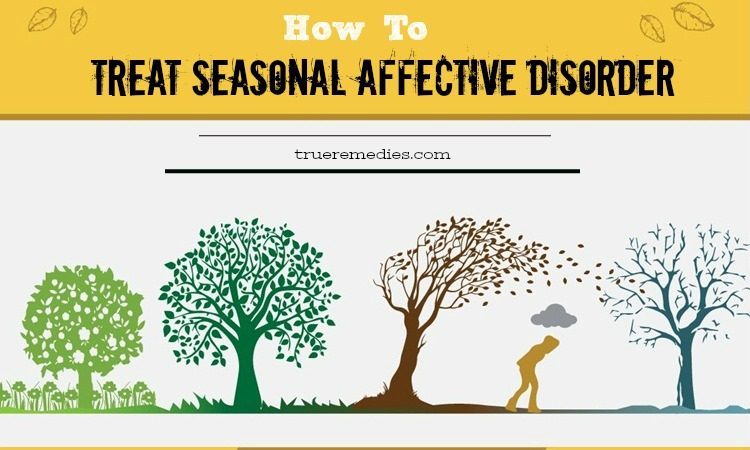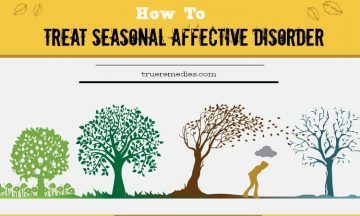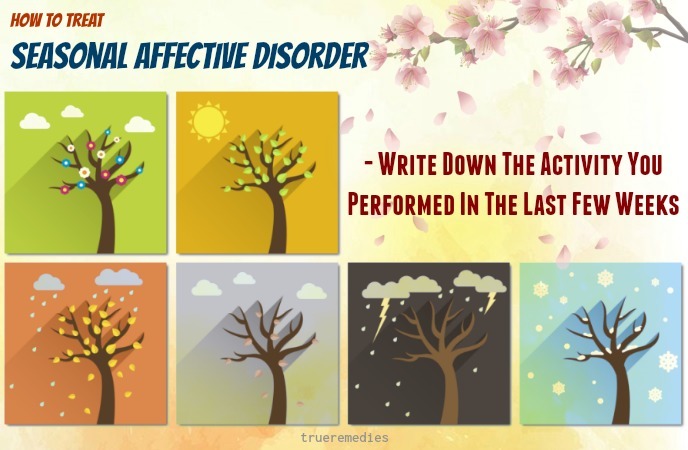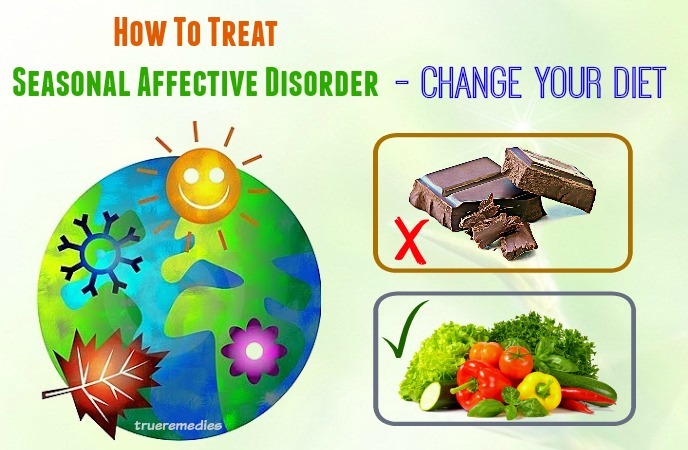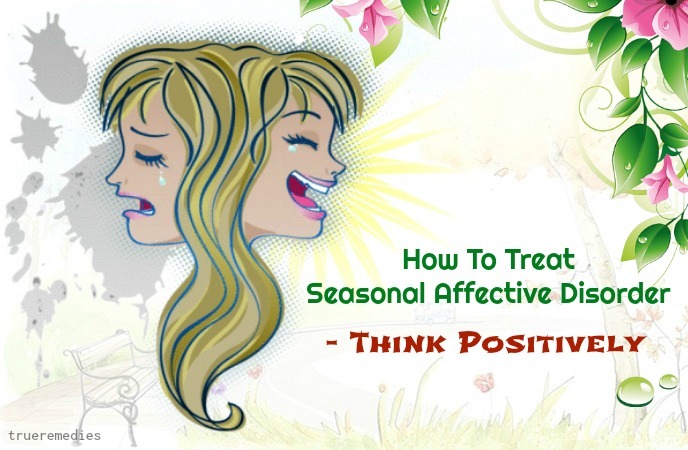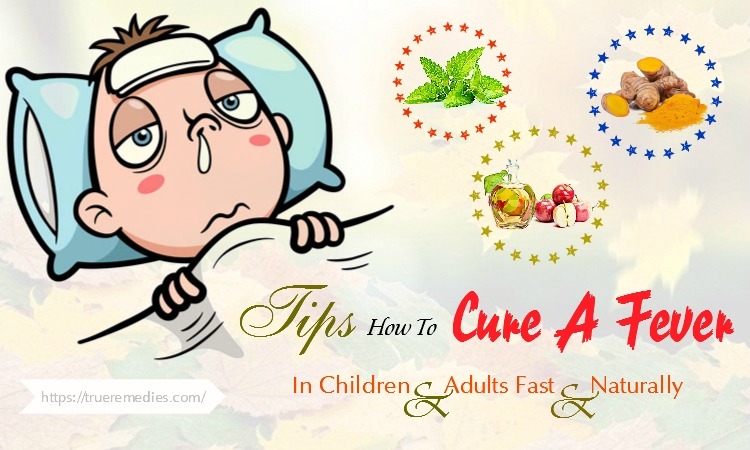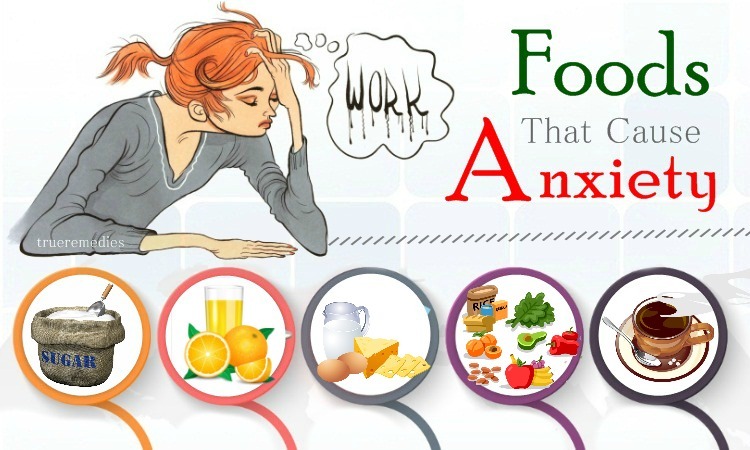Updated: 07/26/2019
Contents
Seasonal affective disorder (SAD) is a common psychological disorder. It seriously affects the daily functioning of patients. This condition may make you feel tired, so you cannot enjoy your life. If not treated promptly, seasonal affective disorder may develop into depression. Are you facing this disease? If so, you need to be aware that the application of natural treatments should be made as soon as possible. Do not worry because you are not alone in this war. This article will guide you on how to treat seasonal affective disorder naturally at home. But to do that, you need to find out more about your problem through the information below.
- 10 Natural home remedies for seasonal affective disorder (SAD)
- 32 Home remedies for depression, anger & stress symptoms
What Is Seasonal Affective Disorder?
The seasonal affective disorder is often referred to as SAD. It is a type of depression that occurs in the same season each year. If you get it, the symptoms will begin to manifest in the fall and continue in the winter months, reducing your energy and making you feel sad. In some cases, seasonal depression causes depression in the spring or early summer. However, this condition is very rare. The seasonal affective disorder usually affects people at the age of 18-30. Now, there are some studies that prove that the disease is inherited. Heredity causes the patient’s eyes to become very sensitive to light. In seasons with little sunlight, the mood of patients is likely to change in a positive way. This seems to be in contrast to a disorder that causes patients to become extremely sensitive to intense light[1] [2].
Today, doctors have developed methods for treating seasonal affective disorder, including light therapy, psychotherapy, and medicine. When you experience the symptoms of seasonal affective disorder, you probably do not want to contact anyone. Then you do not think you are suffering from a disease. That is why many patients do not cooperate with their doctors during treatment. Do not deny this symptom every year, such as the sadness of winter or the loneliness that you suffer from. Get the help of friends, relatives, and doctors to keep your mood and motivation stable throughout the year. It is important to believe that life is beautiful and you deserve happiness.
What Are Common Causes Of Seasonal Affective Disorder?
There is no exact cause for seasonal affective disorder, and the risk factors may vary from person to person. Here are some risk factors that are given by the researchers[3]:
- Light
People living in areas with longer winter nights (high latitudes) and less sunlight are more likely to develop the disease. For example, seasonal affective disorder is more common in Canada and Alaska than in Florida. Light is believed to affect patients. Many researchers believe that reducing exposure to sunlight affects the natural circadian clock that regulates hormones, sleep, and spirit[4] [5]. Other researchers think that the chemicals of the brain that depend on light may affect many people with seasonal affective disorder.
TrueRemedies Partner Solutions

Need a Help from the Leading Expert Online, Available 24/7?
They’re all here and ready to answer your questions online or by phone. Keep asking questions until you get the answer you need.
In addition, the lack of sunlight makes it difficult for the body to synthesize vitamin D[6] (the body is difficult to synthesize vitamin D absorbed from food without sunlight) and tryptophan. As you know, tryptophan is a substance that helps the body produce serotonin – an antidepressant hormone. This is the reason why the disease usually occurs in winter – the season has very little sunlight. Have you ever wondered why you often feel very sleepy in winter? This is because the lack of sunlight makes the body very difficult to produce serotonin, but produces a lot of hormone melatonin[7]. This makes you feel tired, sad, and sleepy.
- Temperature
For many people, the temperature may cause great physical and mental stress[8]. When the weather is cold, you always want to hide in your bedroom or in a warm room rather than participating in outdoor events. Low temperatures may make you less active, so you always want to get more rest. Cold and dry weather may also cause your skin to dry, causing you discomfort. All this makes you very susceptible to seasonal affective disorder.
- Allergy
In humid and cold weather, you are prone to allergies due to mold, dust, or pollen. Researchers believe that allergies and respiratory diseases cause seasonal affective disorder in some people[9] [10].
- Disruption In Routine
For some people, disruption in routine and daily life schedules may make them feel stressed. In most cases, winter often results in more activities that take up most of the day, which may cause sleep deprivation, poor work performance, and unhealthy eating habits.
- Vacations
Winter is a time when many people participate in holiday and travel activities. However, due to some conditions such as finance, time, health, etc., some people cannot enjoy the holiday. That will create jealousy and sadness, damaging their mental health.
- Financial Concern
Winter is the season of festivals and holidays. This has led to increased financial pressures. Then, seasonal affective disorder is unavoidable.
- Eating Habit
The cold season, especially the festive season, makes your eating habits go upside down. Attending meetings with family, friends, or colleagues causes your stomach to overload and bloat. Consuming too much greasy food and drinking too much alcohol causes your body not to get enough energy. So, you are prone to getting tired, feeling dizzy, and depressed.
- Do Not Exercise Regularly
Many studies have confirmed that exercise is closely related to your mood[11] [12] [13]. If you exercise regularly, you can maintain very positive thoughts. However, when the weather is cold, you always want to be sitting by the fireplace rather than going out and running. That also causes you to be depressed.
What Are Common Symptoms Of Seasonal Affective Disorder?
The seasonal affective disorder is a subset of depression and occurs seasonally. Therefore, the symptoms of depression may be part of seasonal affective disorder, such as:
- Feeling depressed all day or almost every day
- Feeling hopeless or worthless
- Lack of energy
- Losing interest in activities you enjoy
- Having problems with sleep
- Changes in diet or weight
- Being easily provoked
- Difficulty in concentrating
- Often thinking about death or suicide
Depression in the fall and winter manifested as:
- Uncomfortable
- Tired or lack of energy
- Problems in communicating with others
- Too sensitive to be rejected
- Feeling tired in the arm or leg
- Sleeping too much
- Changes in eating habits, especially like eating carbohydrate-rich foods;
- Weight loss
Spring and summer depression can manifest as:
You may experience other symptoms not mentioned. If you have any questions about the signs and symptoms of the disease, please consult your doctor.
What Are Risk Factors?
The seasonal affective disorder is more common in women than men. It may affect people at the ages of 18 and 30. In addition, if you have seasonal allergies, you are also more likely to suffer from seasonal affective disorder. Younger people are at higher risk for winter depression while it is less likely to occur in adults. There are clinical depression and bipolar disorder. The symptoms of depression can be worse than the seasonal affective disorder if you have one of these conditions. You can control this problem by minimizing risk factors. Please see your doctor for more information.
When To See A Doctor?
If you have any of these signs and symptoms or have any questions, please consult your doctor. Each person’s condition is different, so please consult your doctor to select the most suitable option.
Above are some basic information about seasonal affective disorder. As we said above, this disease causes a lot of negative impacts on your life. It makes you cannot find joy in your life. Then, life becomes very meaningless. Below, we introduce you tips on how to treat seasonal affective disorder naturally at home. Have a look at!
Top 20 Tips On How To Treat Seasonal Affective Disorder Naturally At Home
1. Write Down The Activity You Performed In The Last Few Weeks
The first tip in the list of tips on how to get rid of seasonal affective disorder naturally at home is to write down what you did. Try to record the list of all activities (go to work, go to school, eat and wash). Observe whether or not patterns appear in these activities. You should also keep in mind the frequency of certain activities that you usually do voluntarily and cheerfully. Use this list to track whether you have risky behavior. Seasonally depressed people often take risks because they no longer care about their lives, and they need the care of others. If you suffer from seasonal depression, this is a difficult task to accomplish. Writing down your thoughts and daily activities may affect positively on your mood. It helps you get rid of some of the negative feelings from your system[14]. Spend some time, or ask relatives or friends you trust to help write the list.
2. Ask Others If They Notice The Difference In Your Mood
The next must-try tip on how to treat seasonal affective disorder at home is to talk to your relatives or close friends to see if they find out your actions have changed. The experience is the most important, but opinions from others are equally important. People close to you may find you often sad, crying, or unable to do simple work such as taking a shower. In the course of treatment, you need the help of those around you.
3. Use A Light Box
Since outdoor hours are limited in the winter months, using a lightbox will help you reduce symptoms of SAD. It is worth investing because 60-80% of SAD sufferers saw improvements in their condition. Up to now, this is considered the best natural treatment available[15]. According to A 2014 study in the Journal of Affective Disorders, using lightbox treatment in one week is as effective as two weeks, although most people continue using light therapy during the entire season that they are affected[16].
Also known as light therapy, using a lightbox will help you increase your chances of being exposed to the artificial light during the hardest time. As a SAD sufferer, you should use light therapy every day, from the moment you see the first symptom until the spring months when this condition resolves on its own.
Oftentimes, after 15 to 30 minutes of using light therapy daily, you will feel improvements. The improvements are sensed after 2-4 days of application[17].
As SAD symptoms will quickly return after you stop using the therapy, you should consistently use this method during the wintertime to get best results. Besides, you had better carry out this method in the morning to avoid trouble falling asleep in the evening.
You do not need to have a prescription to make use of light therapy; however, there are also side effects associated with this therapy, such as eye strains or headaches. Due to UV exposure, you should see a healthcare provider specializing in light therapy to get proper advice on the right amount of light and the way to filter out those dangerous ultraviolet rays.
4. Use Vitamin D Supplement
The sunshine vitamin has been proven to reduce the severity of depression. People with SAD usually have low vitamin D levels[18].
Though there is not enough scientific evidence behind the effectiveness of vitamin D supplements for our health and well-being, it is worth consulting your doctor to warrant that your vitamin D intake is suitable for your own health condition. Most U.S adults have vitamin D deficiency, so using a supplement may help you improve your immune system, boost bone health, and make you feel better.
5. Consult Your Doctor If Your Physical Condition Causes Seasonal Affective Disorder
In regard to learning how to treat seasonal affective disorder at home, knowing the root cause of your issue is important. In such cases, consulting a professional will help you a lot. Some diseases may lead to depressive symptoms, especially those related to the thyroid or hormones of the body[19]. Talk to your doctor to determine if a certain current illness causes your SAD condition. In these cases, you need to see a doctor to determine the cause of symptoms and how to overcome it.
6. Find Help From A Mental Health Professional
There are many specialists in the field, each with different therapies, including psychiatrist counseling, clinical psychologist, and psychiatrist. You may meet one or more specialists. Make sure you choose the licensed doctor. Mental health professionals must have a work permit. The Psychology Association website provides basic information on how to choose a qualified doctor who has a degree.
- Psychiatrist Counseling
Psychologists provide counseling to help patients overcome difficult times in their lives. This therapy can be a short or long term, and it usually focuses on specific problems. Consultants tend to ask questions and then listen to your answers. They will be objective observers to help you identify key ideas and phrases. They will discuss more detailed ideas to help you deal with the emotional and environmental issues that cause seasonal affective disorder.
- Clinical Psychiatrist
Clinical psychiatrists are trained to perform the test to make the diagnosis, so they usually focus on psychological issues or research on behavioral or mental disorders.
- Psychological Doctor
These specialists apply psychotherapy, assessment scales, or tests to assess the patient’s condition. But they often advise patients to use drugs to treat the disease. In most provinces, only psychiatrists are allowed to prescribe medication.
Psychiatrists tend to ask questions and listen to your answers. At first, you will have difficulty in speaking to them, but most people will want to talk to their doctor after a few minutes. Besides, you should find someone to help you feel comfortable and pleasant. Inappropriate counseling may make your condition last longer, leaving your treatment less effective. You need to remember that not all mental health professionals are right for you. You should find the right counseling and use their services.
Do not forget to check health insurance. Although insurance generally applies to mental illnesses, the degree of development of the disease will determine the time and type of psychotherapy. Before you start any treatment, you should discuss this with your insurance company about this.
7. Change Your Diet
No wonder, diet plays a crucial role in our physical and mental health[20]. Thus, having a well-balanced diet should be part of your process of finding the answer for “How to treat seasonal affective disorder?” As you know, eating too much oily food and drinking too much alcohol also causes you to suffer from seasonal affective disorder. Here are some notes for you during the course of treatment:
- Do not eat foods that contribute to seasonal depression. Prepared foods, processed meats, chocolates, sweet desserts, fried foods, processed cereals, and high-fat dairy products are known to cause depressive symptoms. Therefore, limit the intake of these foods.
- Eat a variety of foods that work to suppress depressive symptoms. These foods include fruits, vegetables, and fish. You should eat plenty of these foods to provide nutrients and vitamins that help your body stay healthy[21].
- Apply the Mediterranean diet. This is the area known for eating mainly fruits, vegetables, fish, beans, legumes, and olive oil. Applying this diet also requires that you limit your intake of alcohol.
- Enhance absorption of omega-3 fatty acids and folic acid. There is no evidence that boosting omega-3 fatty acids and folic acid is effective enough to treat seasonal affective disorder, but omega-3 fatty acids and folic acid have some effects on improving this disease when combined with other therapies.
8. Physical Training
As you all know, one of the causes of seasonal affective disorder is not regularly exercising. Talk to your doctor or personal trainer to start a practice regimen. Before exercising, you should choose exercises appropriate to your interests, health, and history of injury. Consult your doctor or personal trainer to evaluate your self-training. The specialist will also help you identify which exercises are safe and fun, and which ones give the motivation to start.
Exercise boosts emotions and prevents recurrence[22] [23]. In some randomized controlled trials, exercise has been shown to have similar effects to medications. Experts say exercise improves the body’s ability to release neurotransmitters and hormones, as well as regulate sleep. The advantage of exercising as a treatment for seasonal affective disorder; e.g., physical activity such as running does not cost you a penny.
Some activities such as swimming, jogging, or biking are effective exercises that aid in overcoming depression and seasonal affective disorder. You can choose joint cardiovascular exercise, such as swimming or cycling if you can. Communicate with friends or family about taking physical training. They will motivate you to exercise outdoors or to the gym. You should explain that promoting yourself is not easy, but you absolutely appreciate any support.
9. Write Diary
Writing a diary is regarded as a simple but effective way on how to treat seasonal affective disorder symptoms at home. Use a diary to recognize the factors that affect your mood, energy, health, and sleep. Writing a diary also helps you deal with emotions and identifies the cause of the present feeling[24] [25]. You can learn from diaries writing instructors, diary writing guides, and online journaling sites if you need to use more structures. You should make a habit of writing your diary every day, even if you only spend a few minutes a day. There are days when you will want to write a lot, while others will not be interested in writing. Writing will be easier if you practice writing regularly, so you should persevere and wait for the results to happen.
Always carry a notebook and a pen. You will easily record what you want if both pen and book are available. In addition, you can use a simple note software which is installed on your phone, tablet, or other devices. Record any content you like. Just “drop” the words and do not worry too much about their meaning. You do not have to take too much spelling, grammar, or style, and do not care about other people’s thoughts. You can hide your own diary if you want. You can also share some content with family, friends, or a specialist if you find it helpful. You can also write a blog. Everything depends on you and the comfort level of writing the diary.
10. Ask Your Psychiatrist About Antidepressants
The next treatment in this list of tips on how to treat seasonal affective disorder at home is using antidepressants[26]. This drug affects the nervous system of the brain that inhibits negative emotions. Antidepressants are classified based on the neurotransmitter that they affect. Common antidepressants include SSRIs, SNRIs, MAOIs, and tricyclics. You can find on the internet the names of widely used antidepressants. Psychiatrists will prescribe medications that are appropriate for your condition.
A psychiatrist may ask you to take various medications until you find the right type. Some antidepressants have a negative effect on patients, so keep a close relationship with your doctor and take note of any negative or unwanted mood changes. Sometimes you need to take other medicines to solve your disease. Antidepressants take time to exert their effects, as they regulate the brain’s chemical equation at a slow and steady pace. In general, you should take medicine for at least three months to get the desired effect.
The seasonal affective disorder often makes you feel lazy, tired, and sleepy. However, you are very hard to sleep well. Therefore, you can also consult a psychiatrist about the use of sedatives[27]. If antidepressants do not work, psychiatrists may recommend one of three sedating medications (aripiprazole, quetiapine, or risperidone). In addition, you can take combination antidepressant/sedative (fluoxetine/olanzapine). These drugs may treat depression if antidepressants do not work. In order to optimize the effectiveness of the drug, you should continue to see a psychiatrist regularly while taking medicine.
11. Use The SMART System To Set Goals
This sounds strange when it comes to tips on how to treat seasonal affective disorder at home, but it works. For the exercise to be effective, you should set goals for SMART, which stands for Specific, Measurable, Attainable, Realistic, and Timely[28]. Follow these instructions, and you will feel the taste of winning the goal. Start with the “A” criteria in SMART to set goals. You should build the first feasible goal because if you achieve the goal, your mood will become better. In addition, you will also be confident when you set your next goal. If you cannot motivate yourself to do more (such as walking 10 minutes a day), you can encourage yourself to do more (such as walking 10 minutes a day for a week, then a month, and finally throughout the year). Then you will know how long you can maintain the training.
You should consider each workout to improve your mood and think positively for change. Even a five-minute walk with average speed is better than no exercise. You should be proud of your accomplishments, whether large or small, as it will motivate you to move forward on your emotional recovery way.
12. Exposure To The Sun
This small tip brings unexpected results in regard to how to treat seasonal affective disorder at home. Some studies suggest that sun exposure has a positive effect on emotions[29]. The reason is that the effects of vitamin D come from a variety of sources (not just the sunlight). Some prescription consultants use solar lamps for depressed patients living in areas where there is little sunlight in the winter. This type of lamp works the same way as when going out in the sun. If you are going out for a long time, you should apply sunscreen and wear sunglasses to protect your skin.
Spend more time outside. You can garden, stroll, and perform some outdoor activities to enjoy the benefits of sunshine and fresh air[30]. Enjoying fresh air will help relax the mind and relax the body. Besides, you can also participate in creative activities. Researchers believe that creativity in depression is related to one another, such as the susceptibility of creativity[31]. However, depression usually occurs when a person is unable to recognize their creative potential. Therefore, you should regularly write, paint, dance, or perform some other creative activities.
13. Maintain Good Relationships
Although you want to be alone and stay away from others, your mood will be better if you spend time with others[32] [33]. Trust your friends and family members. Spend a lot of time meeting people who can help you feel optimistic about yourself and your life. Good friends not only help you overcome seasonal affective disorder by sharing about it, but they can also make you feel loved and helped.
It’s best for you to spend more time with family. Your family will make you feel loved and shared, so try to spend a lot of time with them. If your family is in another country, take the time to call them as much as possible. If you have a friend or family member who suffered from this disease, talk to them, and take their advice. Sharing your condition with experienced people is really beneficial for your treatment.
Besides, you need to clarify your relationships into good and bad ones. Then, try to get yourself rid of bad relationships. If someone makes you so miserable, it’s time to give up on that relationship, so you do not feel bad again. If you cannot give up that person, for example, a relative in your family, you can spend as little time with that person as possible.
14. Think Positively
To know how to treat seasonal affective disorder at home, you should start your treating process from your own mind. Thinking positively helps you look at life and the world with hopeful eyes instead of disappointment[34] [35]. Let’s think more positively; then you will learn to recognize negative thoughts and quickly eliminate them with positive thoughts at any time. To get positive thoughts, find at least five things that make you happy every day. If you act positively, you will think positively. Think about the good things in life and spend time doing things that make you happy. If you spend more time thinking about things that make you smile and spend less time thinking about things that annoy you or things you do not like, you will find yourself thinking more positively.
15. Improve Sleep Habits
Improving sleep habits has a powerful impact on improving your mental health[36]. Make a sleep schedule that suits you. Here are some things you can do:
- Go to bed and wake up at a certain time every day. This will help you feel good and easy to fall asleep at night and wake up in the morning.
- Quickly get out of bed and drink a glass of water instead of shutting down the alarm clock and continuing to sleep five minutes before you get out of bed.
- Create a good sleep habit. Relax for an hour before going to bed by turning off the TV, turning off the phone or tablet, and avoiding loud noise.
- Limit or remove caffeine in your menu, especially in the afternoon. Caffeine will make you have trouble sleeping.
- Avoid having a nap longer than thirty minutes, unless you really need to sleep – it will only make you feel numb and tired.
16. Looking For New Passion
The next tip on how to treat seasonal affective disorder at home is looking for a new passion. You may not like your current job but now may not be the time for you to change jobs. Pursuing a new passion may help you feel more motivated, and it gives you a reason to wake up in the morning[37]. Passion can be anything you really care about, even if it may not be good at it. Here are some ways to find new passions.
- Discover the artist ability in you. Apply for a painting or watercolor painting class, or make porcelain and pottery.
- Express yourself through writing. Try writing a few poems, short stories, or even the first chapter of a novel.
- Search for excitement with a foreign language.
- Discover a new sport. Join a karate, dance, or yoga class.
- Discover a new team sport such as volleyball or football. You will find new feelings when making friends with many people.
- Discover your love for reading by joining a book club.
17. Join The Events And Activities You Like
If you want to take control over SAD symptoms, consider joining the events and activities that you like[38] [39] [40] [41]. A busy schedule will force you to focus and constantly think about the next in your job list. You can plan for each day at the beginning of a new week or simply plan for each day the night before. Whatever you choose, you also need to set goals according to this plan. Here are some things that you should take time to do:
- Do exercise.
- Pursue your interests and passions.
- Take time to relax and write a diary
- Take time to do something that looks silly but makes you laugh.
- Join outdoor activities. Do not spend all your time indoors. Instead, go out for the sun or do homework every day or read a book at a coffee shop.
18. Be More Generous
As mentioned earlier, the financial pressure, especially during the holiday season, makes you vulnerable to seasonal affective disorder. To overcome this, be generous with your beloved friends and those around you. If you are generous, you will feel happier, more confident, and build better relationships with those around you[42] [43] [44].
19. Help People Around You
This sounds irrelevant regarding tips on how to treat seasonal affective disorder at home, but helping people around can do the trick for your condition[45]. Many people try to overcome seasonal affective disorder by joining a local volunteer team. You can volunteer at the library where you live to help adults and children discover the joy of reading. You can also do volunteer work in an aged care center, youth organization, or homeless shelter and see the difference you have made. Much more than that, you can also do community volunteering by cleaning the park. Just taking the time for nature may help you feel better.
20. Improve Your Appearance
Sometimes, a small change in your appearance also does a great job of treating your SAD condition. Having no personal hygiene is a common manifestation of seasonal affective disorder. Although you will not be able to get rid of depressive symptoms by improving your appearance, however, if you spend some time taking care of your appearance and personal hygiene daily, you will feel more confident. Bathe and brush your teeth every day. Dress well when you meet people no matter how bad you feel. This will give you confidence and respect yourself.
The aforementioned are tips on how to treat seasonal affective disorder naturally at home. As you can see, they are all very useful. Do not hesitate to apply them today because your condition needs to be treated as soon as possible. If you have any contributing ideas about our article, do not hesitate to drop your words below this post. We will answer as soon as we could.

